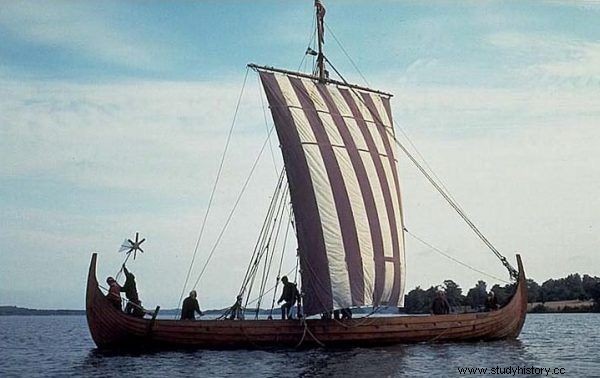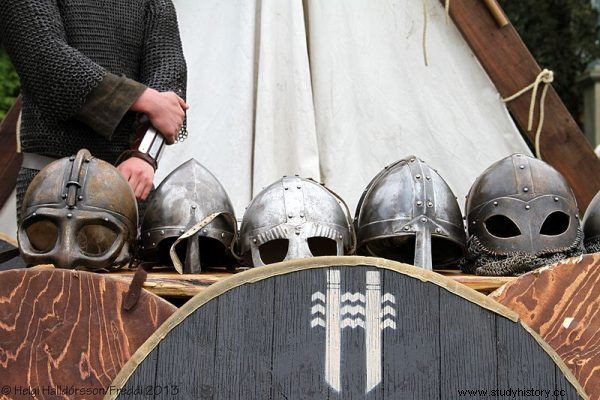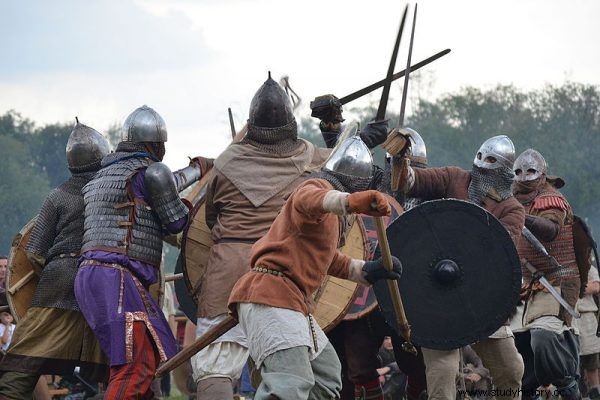A fair-haired, blue-eyed muscular man who, together with his companions in animal skins and characteristic helmets, regularly loots settlements on the coasts of England and France, raping and murdering whomever he can - this is the image of a Viking known from movies or novels. But is there any truth to it?
There are probably no warriors in European history with so many myths and legends as there are about the Vikings. It turns out, however, that the attributes assigned to them stereotypically do not necessarily reflect reality in 100%. Not only that, some of them are completely untrue! Here are five popular claims about brave Norse warriors that are utter nonsense - or at least a fair amount of abuse.
1. They were highwaymen and plunderers with only a war in their heads
The savage, brutal invaders from the North who plundered St. Kutbert's Church off the coast of Britain in 793 are immortalized on the famous Lindisfarne stone. As we read in Robert Ferguson's book The Hammer and the Cross. A new history of the Vikings , the bas-relief “shows seven marching men in profile. The figures at the front and back of the column are unarmed, presumably due to the lack of space on the semicircular stone. The two central figures are holding axes and the three behind them are swords . [...] They march with their heads held high and their torsos stretched, raising their weapons with one hand as if to deliver a blow. "
This and other historical sources present the Vikings in a clearly negative light. No wonder then that the image of Scandinavian peoples conveyed on the basis of this kind of "documentation" is rather dark. But does the black legend of the Norse warriors have anything to do with reality?
Well, there is at least a grain of truth in it. Some Viking expeditions were indeed aggressive in nature, but just as often medieval Scandinavians went out to sea to find trading partners, to find new places for a settlement, or simply out of curiosity. And even when they set out with the idea of looting, they were usually driven by economic considerations - not an inborn propensity to violence.

The sight of the Viking boat was supposed to cause panic among the English and French. However, there are many indications that the neighbors mostly enjoyed the visits. They foreshadowed trade.
The invasions on the British Isles and the coasts of Europe at the end of the 8th century were probably one of the many episodes caused by ... famine. Therefore, they probably did not happen in periods of prosperity - then the inhabitants of the North maintained proper contacts with their neighbors. The sagas handed down from generation to generation say as much about wars as about journeys to discover new lands .
Many Vikings abandoned their wandering to settle permanently in one place. This was the case, for example, in Normandy, where, after stormy war escapades, with the anointing of Charles III the Prostak, he settled down and became Count Rollon. This is how Bernard Cornwell describes the dichotomous nature of medieval Scandinavians in his best-selling novel The Last Kingdom :
They were called Vikings when they were seaside raiders and Danes or pagans when they traded. The people of the three ships were therefore considered Vikings because they were burning and looting homesteads (...). In every bay, harbor, and river mouth, people trembled for fear that long Viking boats would suddenly emerge on the horizon line. The dragons in their beaks were terrified, the men who followed these dragons were feared, and it was prayed that God would spare them the fury of the people of the North .
2. They had blonde hair, blue eyes, and superhuman strength
When we think about Vikings, we see a picture of fair-haired and blue-eyed men, extremely strong, brave and aggressive by nature. The truth is, however, that these people were not significantly different from the typical European - they were slightly taller and had a slightly thicker stature. So where did the vision of sailing warriors come from?
After the famous attack on the monastery in Lindisfarne, the following text remained:"In that year, terrible signs appeared over Northumbria and greatly terrified its inhabitants: unusual lightning flashed and fire dragons were seen flying in the air . Soon after these signs came a great famine, and not long after that, that same year, pagan raiders, like devils, pitifully destroyed God's church in Lindisfarne with rape and slaughter. "
Catholic clergy feared the Vikings most of all. Moreover, they are not surprised:monasteries and churches were easy targets for those who did not know the European concept of holiness. And it is to a large extent that priests and religious are responsible for the black PR around the Nordic warriors. They were the first to endow the "barbarians of the North" with devilish qualities.
Oil was added to the fire with the discovery in 1880 of the burial mound in which the boat rested and the remains of a Viking. According to research (carried out only in 2007), it was the body of a man about 40 years old, 181 cm tall - 15 cm above the average at that time - and with very heavy bones. Years passed before it was revealed that the deceased had suffered from an adenoma or pituitary tumor that had caused his symptoms of gigantism.
Meanwhile, in the nineteenth century, when the tomb was discovered, scholars quickly combined facts with historical legends. The result was the image of a Viking giant. And it continues to this day, despite the fact that modern, comprehensive DNA tests carried out by anthropologists prove that people from the North - although slightly taller than average - did not dominate so much over the English or French they attacked (men measured 171 cm on average, and women - 158 cm).
What about hair color? Well, the scientists did not make any rules on this point. Probably among the Vikings of Swedish origin, blonde hair was the dominant one, but the Norwegians and the Danes had rather dark or red hair.
3. They wore horned helmets
This is perhaps the most popular myth about the Vikings - and at the same time the least truthful. Horned hats are often found in the pages of novels and movies, while archaeologists have found no traces of such "fashion" among the people of Scandinavia. So where did the devil's helmets come from?

There were no horns on Viking helmets - but the myth of the devil's headgear is still fine.
The "blame" for the creation of this myth is probably the theatrical costume designer, Cami Emil Doepler, who wanted to attract the attention of viewers with his characteristic Viking character . He decided that a horned helmet would be the best for this purpose and put his idea into practice by creating costumes for the Wagner opera Ring of the Nibelung in 1876. Apparently, Doepler's vision was so good that it became permanently embedded in the minds of mass culture recipients. No wonder, after all, it fits perfectly with the supposed "devilishness" of these people.
But that's not the only theory on this subject. According to another hypothesis, the characteristic helmet was supposed to reflect the image of Odin, on whose shoulders two ravens sat:Hugin and Munin. Birds flew around the world every day to gather the latest news and then passed it directly to the ear of god.
Meanwhile, helmets from the period of Viking expeditions do not have any horns. Rather, they are fairly simple headgear with eye protection and no ornaments . The horned helmets on display in some museums date back to an earlier period - the Iron Age - and were probably used in ceremonies rather than in battle.
Currently, mass culture is slowly giving up cultivating this myth. While in not very serious productions the Vikings are humorously portrayed with horns on their heads, in those more faithful to history this element will not be found. The horned helmets are not present in the newest series about warriors of the North, nor in the novel by Bernard Cornwell.
4. Their cruelty knew no bounds
This myth, too, is the result of a clash between two different cultures - pagan and Catholic. The Vikings were a hardened people and more than once showed a tendency to aggression and cruelty. There were also times when they tortured their victims. But did they actually fall short of the average for their time on this point? Probably not…

Contrary to commonly repeated myths, the Vikings were not particularly cruel or overwhelmingly eager to fight - or at least they did not stand out from the average in this respect.
It must be remembered that at that time all of Europe was engulfed in wars of lesser and greater, and blood was flowing in streams in virtually every corner of it. The rulers had to deal with their opponents definitively to keep their position. So, fighting to the death was just a way of looking after your own interests. And the Vikings - people adapted to the times in which they lived. The only difference was the ignorance of the concept of holiness:for the invaders from the North, the monastery or the church was the same building as the others, full of loot, and the monks - easy opponents.
Besides, the approach to other cultures at that time was completely different than today. When the Scandinavian warriors contacted the people of France or England, they were often immediately classified as "stupid barbarians." Therefore, their cultural identity remained separate from the European one, which caused hiccups to Viking enemies during periods of plunder. As Robert Fergusson writes:
The psychopathic fury of the invaders, marked by the same inhuman indifference to the victims that characterized Charlemagne against the Saxons, found an outlet in the infantile brutality of transgressive behavior, offering the satisfaction of breaking the taboos of one's own and one's own victims. Simeon of Durham noted that attackers were deliberately drowning monks into the sea; perhaps it was meant to be some cruel parody of baptism .
5. They avoided bathing
Today, the Viking is often presented as a dirty, sweaty and sea-wind-battered giant, for whom the basic rules of hygiene are limited to accidental bathing in the sea. Meanwhile, the truth was completely different.
Archaeological research has revealed that medieval northern peoples used combs, tweezers and razors on a daily basis. What's more, they took great care of the hairstyle and careful brushing of the beard. John of Wallingford wrote in the thirteenth century of the Vikings as "woman's heartbreakers." Surely smelly, disheveled men wouldn't be that successful.
And that's not all! The word "Saturday" in Old Scandinavian literally means "washing day" , which proves at least a certain care for clothes (and compared to Europe at that time, washing once a week was the ultimate in hygiene anyway).
The Vikings had to really shine against the background of other cultures, as evidenced also by the fashion for their hairdos, costumes and art, which emerged at the court of King Ethelred, who ruled in England at the turn of the 9th and 10th centuries. As the scholar Alcuin wrote to the king:“Look at these luxurious robes, hairdos, manners. See the resemblance to pagan hairstyles and beards? Aren't the people you want to emulate the same barbarians who oppress us? ”.
Inspiration:
This article was inspired by Bernard Cornwell's novel "The Last Kingdom", which was published by Otwarte publishing house. This is the first volume of the best-selling series about the turbulent times of the Viking invasions of England in the 9th century.
